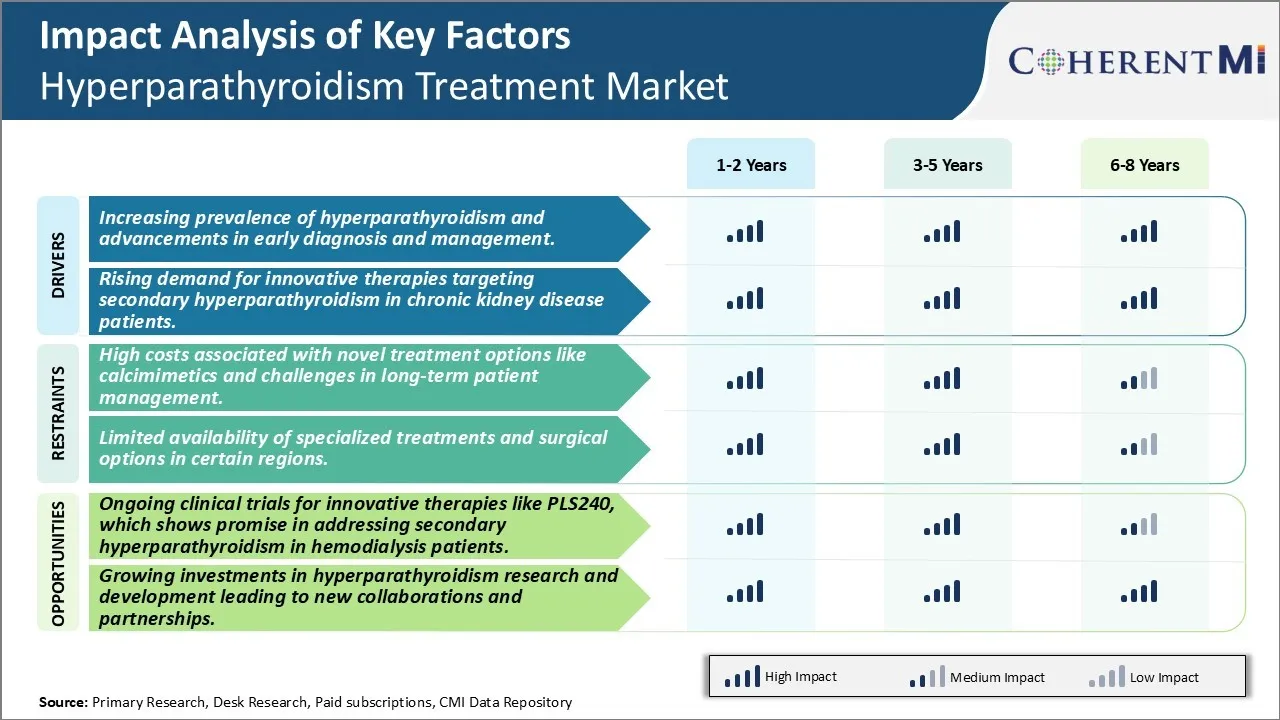

グローバルHyperparathyroidism 治療市場は評価されると推定される 2025年のUSD 835.5 Mn そして到達する予定 米ドル 1350.4 によって Mn 2032, 化合物年間成長率で成長 2025年から2032年にかけて7.1%のCAGR。
hyperparathyroidismの処置の市場はhyperparathyroidの無秩序の上昇の優先順位および最低の侵襲的な外科の採用の増加による予測期間上の肯定的な成長を目撃することを期待されます。 最近の調査によると、hyperparathyroidismは米国で毎年1000人の成人で1つに影響を与えます。 成長するgeriatric集団では、第一次ハイパーパラチオリズムの症例はより速いペースで増加し、従って処置の解決のための要求を運転しています。 さらに、医療イメージング技術の進歩により、異常な副甲状腺の正確なローカリゼーションが実現し、最小限の侵襲的副甲状腺切除術(MIP)などの侵襲的手術が最小限に抑えられます。 MIP のプロシージャはより低いヘルスケアの費用、より少ない外科合併症およびより速い回復時間に終って小さい切開を要求します。 侵襲的外科医に対するこの傾向は、予測期間中にハイパーパラチオリズム治療市場の成長を支持しています。
市場規模(米ドル) Mn
CAGR7.1%
| 調査期間 | 2025-2032 |
| 推定の基準年 | 2024 |
| CAGR | 7.1% |
| 市場集中度 | Medium |
| 主要プレーヤー | Pathalysファーマ, 株式会社アムゲン, 武田薬品 会社概要, サノフィ S.A., ローチェホールディングAG その他 |
市場ドライバー - HyperparathyroidismとAdvancementsの普及 早期診断と管理。
Hyperparathyroidism 条件は、首の領域にある副甲状腺から副甲状腺ホルモンの過剰生産が原因で発生します。 このホルモンの過剰生産の背後にある正確な原因はまだ十分に理解されるが、遺伝的および環境的要因は重要な役割を果たしています。 ライフスタイルパターンや食生活習慣の変化に伴い、数十数年を経ち、高度パラチオリズムの蔓延が着実に増加しました。 カルシウムとビタミンDの低ダイエットの長期摂取は、個人がこの障害に陥ります。 また、この条件の家族歴はリスクを高めます。 見積りごとに、1000人の個人が、それを実現することなく、ハイパーパラチオリズムに苦しんでいる可能性があります。
診断方法の進歩は、過去と比較してはるかに初期段階で甲状腺機能亢進症を検出するために医師が有効になっています。 血清intactの副甲状腺ホルモン(PTH)のレベル分析および首のUltrasonographyのようなテストは第一線のスクリーニングおよび診断用具として広く利用されています。 これらのテストは、前の4本の腺外科的探査のような侵襲的なテストに関連付けられているリスクを回避する非侵襲的な手順を診断しました。 その上、医師はまた、今日利用可能な強固なアッセイを借りて、通常と病理学的副甲状腺ホルモンレベルの間でより良い差別化することができます。 この早期診断は、タイムリーな介入が病気の進行を遅くすることを可能にします。
早期診断に加えて、高機能甲状腺機能症の管理も近年大幅に改善しました。 ビデオ主導の副甲状腺切除術および放射免疫ガイド付き副甲状腺切除術のような最小侵襲的な外科方法は従来の両側の首の調査に人気があります。 これらの集中ローカリゼーションアプローチは、従来の手術と比較して、合併症率が低く、より迅速な回復をもたらします。
市場ドライバー - 慢性腎疾患患者における二次甲状腺機能亢進を標的とする革新的な治療法の需要を高める。
慢性腎疾患(CKD)は、糖尿病および高血圧の発生率を増加させることで、世界中で主要な公衆衛生上の懸念として出現しました。 異常に高められた PTH のレベルによって特徴付けられる二次hyperparathyroidismは高度に CKD に適度に患者で観察される頻繁な合併症です。 持続性が高いPTHは、エンドステージ腎不全に対する進行を加速するさらなる悪化の腎臓損傷を克服することができます。 カルシウムサプリメント、ビタミンDステロールおよびリン酸バインダーを採用する慣習的なCKDミネラル骨の無秩序療法は長期にわたるPSTのレベルを効果的に制御する限界があります。 これは、患者と医師の立場からの新しい治療アプローチの需要を燃やしました。
最近、組換えの人間 PTH (rhPTH) は従来のレジメンへのadjunctの処置として有望な結果を示しました。 PTH のアナログの断続的な管理によって正常な毎日のホルモンの変動にteriparatide行為のような薬剤は正常な骨の改造を元通りにするのを助けます。 その他の新興療法は、ブロスマブのような過剰なPTHを標的抗体です。 Cinacalcetは従来のラインに耐火剤か不耐剤のための付加的なPTHの低下の選択として重要な役割をし続けます。 現在では、ナノ粒子などの医薬品や医薬品のデリバリーシステムを組み合わせた次世代の治療法を次世代に評価しています。 継続的な研究の努力は、果敢に証明する必要があります, 優れた治療法の選択肢の可用性は、今後数年間で、市場の可能性を強化する確実である.
要約すると、上記の市場ドライバーは、進行中のイノベーションと相まって病気の疫学のシフトが、この治療領域で動作する企業のためのビジネスケースを集約的に強化する方法を強調しています。 継続的な医療の進歩により、長期にわたる確立された治療方法と新規治療方法の蓄積が向上する臨床結果が向上するという約束が生まれています。
 このレポートの詳細については、 無料サンプルコピーをダウンロード
このレポートの詳細については、 無料サンプルコピーをダウンロード
市場課題 - 長期患者管理におけるカルシミメティックスやチャレンジのようなノベル治療オプションと提携した高コスト。
ハイパーパラチオリズム治療市場が直面する主要な課題の1つは、カルシミメティックスなどの新規治療オプションに関連する高いコストです。 カルシウム-センシング受容体アゴニストまたはカルシミティクスは、プライマリ甲状腺機能亢進症または二次甲状腺機能亢進症の患者における高カルシウム血症を管理するためにますます使用されています。 しかし、これらの薬は、多くの国で大幅な費用の負担と保険のカバレッジを伴います。 例えば、Amgenが販売する主要なカルシミメティックであるCinacalcetは、米国で1人の患者につき1万米ドル超の年間薬費を持っています。 長期投薬の負の影響の処置の付着力の高い費用および公共のヘルスケアの予算のかなりの緊張を台無しにして下さい。 さらに、これらの薬は、副甲状腺ホルモンとカルシウム濃度を制御する上で良好な有効性を示しているが、骨のミネラル密度に対する長期的な安全性と効果はまだ評価されています。 これは、増量症の患者の定期的な監視を必要とし、さらに全体的な治療コストをエスカレートします。 遺伝子の代替品が現れたり、新しい治療法の価格が大幅に下がり、高い治療費は引き続き市場の成長見通しを制限します。
市場機会 - 革新的なセラピー燃料の現在の機会のための臨床試験の開始。
hyperparathyroidism治療市場での主な機会の1つは、革新的な新しい治療のための継続的な臨床試験にあります。 例えば、Paladin Labs の調査薬 PLS-240 は現在、ヘモダシス患者における二次甲状腺機能低下症の管理のためのフェーズ 3 試験で評価されています。 成功すると、PLS-240は、カルシミティックスのような既存の注射薬の代替を提供する経口療法として重要なアンメットの必要性に対処する可能性がある。 副甲状腺ホルモンをターゲティングする他のいくつかの薬剤の候補, カルシウムセンシング受容体とリン酸ホメオステアシスはまた、初期からミッドステージ試験に. 強力な臨床パイプラインは、次の数年が現在の治療の欠点に対処する新しい治療オプションの承認と起動を見ることができることを願っています。 これは、治療パターンを拡大し、プライマリと二次甲状腺機能亢進のより効果的な長期管理を可能にすることによって、市場収益を促進するのに役立ちます。 将来的に持続的な成長機会のために、試験段階から新興する有望な候補。
Hyperparathyroidismは、通常、病気の重症や症状に基づいてステップ単位で治療されます。 軽度の非対症症の場合、初期処理には、ダイエットや血清カルシウムレベルを制御するための運動などのライフスタイル変更が含まれます。
しかしながら、中程度から重症の場合、薬物療法は処方されます。 最初のライントリートメントは、Sensipar(cinacalcet)のような経口皮膜症を含みます。 副甲状腺ホルモン(PTH)の分泌を減少させることにより、カルシウム濃度を正常化し、患者の80%を超える症状を効果的に減らすことができます。
医療療法に失敗したり、副作用に耐えられない人のために、手術は好ましいオプションになります。 Parathyroidectomy、過剰なホルモンの分泌を引き起こす副甲状腺の1つ以上を取除くことを含む、治療の最良のチャンスを提供します。 すべての異常な腺が正しく識別され、取除かれるとき患者の95%以上は外科の後で完全なremissionを経験します。
手術後でも再発または持続的な症例のために、医師はしばしばFosrenol(lanthanum carbonate)やカルシウムサプリメントなどのリン酸塩の結合剤を処方します。 腸からのリン酸吸収を制御し、十分なカルシウム摂取量を維持することにより、血清PTHおよびカルシウム濃度は長期安定させることができます。
治療の選択肢に影響を与える他の要因には、病気の重症、合併症、症状の進行、費用、忍耐強い好み、および侵襲的処置のリスクが含まれます。 ラボパラメータのクローズモニタリングにより、各ケースのユニークなプロファイルに基づいて治療をカスタマイズできます。
Hyperparathyroidismは症状の重症度に基づいて進行の異なる段階を持っています。 初期段階または非対称性高パラチオリズムは、ライフスタイルの修正と監視だけを必要とするかもしれません。 高度の段階は薬剤の療法か外科を要求するかもしれません。
軽度の症例のために、ライフスタイルの変化は食生活と骨を強化するための運動に焦点を当てます。 食事療法を通して十分なカルシウムおよびビタミンDを維持することは副甲状腺ホルモンのレベルを制御するのを助けます。
適度な場合、薬剤の選択は考慮されます。 Cinacalcet(Sensipar)は、副甲状腺ホルモンの分泌を阻害することによってカルシウム濃度を低下させる最初のライン薬です。 それは口頭および一般に最低の副作用と十分に容認された長期取られます。
より厳しい提示のために、手術は好まれた選択です。 Parathyroidectomyは影響された副甲状腺(s)を取除くことを含みます。 これは、過剰なホルモンの生産の根本的な原因を修正します。. 最小侵襲的な放射線導管パラチオチオは、事前の手術スキャンと術内ガンマプローブ検出を使用して、病気の腺を正確に見つけ、除去する金標準です。
すべての腺が過度に現れた再発症例では、副甲状腺組織のオート移植による総副甲状腺切除術が行われます。 これは、術後のカルシウム代謝を維持しながら治療の最良のチャンスを提供します。
治療計画は、症状の重症度、合併症、および専門家の評価に基づいてカスタマイズされます。 ライフスタイルの変化は初期病に役立ちますが、薬物は非侵襲的な制御と手術を提供し、高度な甲状腺機能低下症のための決定的な治療法を提供します。
R&Dおよび新製品の進水に焦点を合わせて下さい: R&D活動に積極的に焦点を絞った複数のプレーヤーは、高機能化のための新しく、改善された処置の選択を開発する。
買収とパートナーシップ: 企業は、戦略的買収とパートナーシップを通じて、ハイパーパラソイズム製品ポートフォリオと地理的リーチを拡大しました。 同様に、Abbvieは、中国のような新興市場で強力な地域の選手と提携し、そのhyperparathyroidism薬Zemplarを商用化し、国際成長を推進しています。
専門分野に焦点を合わせて下さい: : : 一部のプレイヤーは、中程度から重度の高カルシウム血症のような特定の患者セグメントを標的とする勝ち戦略を開発しました。
上記の例では、新製品の発売、買収/パートナシップ、専門患者グループに焦点を当てた結果、主要なプレーヤーが重要なリーダーシップポジションと販売成長を得るのに役立ちます。
 このレポートの詳細については、 無料サンプルコピーをダウンロード Insights、製品別、Parathyroidホルモンは、その標的行動のメカニズムのために製品セグメントを駆動します。
このレポートの詳細については、 無料サンプルコピーをダウンロード Insights、製品別、Parathyroidホルモンは、その標的行動のメカニズムのために製品セグメントを駆動します。
プロダクトによって、Parathyroidのホルモンは2025の55.8%のシェアのために考慮すると期待されます。 これは、副甲状腺ホルモンは、他の製品タイプに見られないhyperparathyroidismを治療するための作用の標的メカニズムを提供するためです。
Hyperparathyroidismは、体内の副甲状腺ホルモンの過剰なレベルによって引き起こされる。 副甲状腺ホルモンはカルシウムおよびリン酸塩のレベルを調整する重要な役割を担います。 副甲状腺ホルモンレベルが高すぎると、それは骨の損失、腎臓の石および他の健康問題につながることができます。 副甲状腺ホルモンレベルを下げることによって根本的な原因を扱うことは、高甲状腺機能症を管理するためのピボタルです。
副甲状腺ホルモンは、通常の副甲状腺ホルモンの分泌を回復するのに役立つ副甲状腺に直接作用します。 過剰な副甲状腺ホルモンを生成する腺をターゲティングすることにより、根本原因を正確に対処します。 ビタミンDアナログやカルシウムサプリメントなどの他の製品タイプは、同じターゲットの方法で治療を集中しません。
ビタミン Dとカルシウムサプリメントは、カルシウム規制における役割を通じて、副甲状腺ホルモンレベルを間接的に影響することを目指しています。 しかし, 彼らは、誤動作の副甲状腺からの副甲状腺ホルモン分泌を減少させるのコアの問題に取得しません. 作用の直接的なメカニズムのために、副甲状腺ホルモンはこれらの間接処置のアプローチより効果的にhyperparathyroidismを制御することができます。
 このレポートの詳細については、 無料サンプルコピーをダウンロード
このレポートの詳細については、 無料サンプルコピーをダウンロード
洞察, 管理の経路によって, 経口投与は、利便性のために支配します.
管理セグメントの経路内で、経口投与は2025年に54.4%を占める。 これは、経口処理が他の管理経路と比較して比類のない利便性を提供するためです。
多項的甲状腺機能低下症の生涯管理を必要とする患者にとって、経口療法は、静脈内および皮下オプションが一致できないライフスタイルの実用性を提供します。 経口薬では、患者は注射や注入を受ける必要はありません。 臨床医の事務所や自己管理治療などの負担を軽減します。 経口療法の容易さはより高い薬物の付着を促進します。 患者は、厳密に混乱せずに処方された経口療法に従う可能性が高いです。 これは、ハイパーパラチオリズムの緊密な制御を維持するので、健康上の結果を改善します。 その他の管理は、訪問の不便なスケジューリングや医師の不快な不快感などの問題によるリスク非依存性をルートします。
また、経口薬は、他の人が観察または援助を必要としない、控えめでプライベートな投薬を可能にします。 このプライバシーアスペクトは、hyperparathyroidism患者に評価されます。 全体的に、経口投与の比類のない利便性は、その人気と最大の市場シェアを、静脈または皮下代替品の上に駆動します。 また、医療従事者と共鳴する利便性もあります。
Hyperparathyroidismは、副甲状腺ホルモン(PTH)の過剰産生によってマークされている一般的な内分泌障害であり、血中のカルシウムレベルを高め、腎臓石、骨の弱み、疲労などの関連合併症を引き起こします。 診断は、通常、カルシウムとPTHレベルを測定するために血液検査を伴います, 任意の腺異常を検出するためにイメージングと一緒に. 特異的な原因と治療アプローチのそれぞれ、主的、二次的、およびtertiaryの3つの形態があります。 第一次甲状腺機能亢進症は、しばしば良性腫瘍によって引き起こされますが、二次甲状腺機能低下は通常、慢性腎臓病またはビタミンD欠乏にリンクされます。 処置は影響された腺の外科取り外しかビスフォネートかカルシマイオティックのような薬物の使用に非対症の場合の驚くべき待っているから及ぶことができます。 Pathalys Pharma は、フェーズ III の試験において、新規の発熱性 PLS240 を開発しています。これにより、透析を受けている患者における二次甲状腺機能亢進症の治療を強化することが約束されます。 PLS240などの新療法の開発は、早期発見と管理の進歩とともに、今後数年間で高機能甲状腺機能症の市場の成長を促すことが期待されます。
ハイパーパラサイト症治療市場で活動する主要なプレーヤーには、Pathalys Pharma、Amgen Inc.、Takeda Pharmaceutical Company Limited、Sanofi S.A.、Roche Holding、Novartis AG、Abbvie Inc.、Kyowa Kirin、Ltd. Shire Health、chire heath co. inc。
2024年5月、Pathalys Pharmaは、Phase IIIの臨床試験において、Phase III(PLS240)の開発を発表しました。 この薬剤は高められた副甲状腺ホルモンのレベルの管理を改善する潜在性を提供します、慢性腎臓病に苦しむ患者のための新しい処置の選択を提供します。
購入オプションを検討しますか?このレポートの個々のセクション?
Ghanshyam Shrivastava - 経営コンサルティングとリサーチの分野で 20 年以上の経験を持つ Ghanshyam Shrivastava は、プリンシパル コンサルタントとして、生物製剤とバイオシミラーに関する幅広い専門知識を持っています。彼の主な専門知識は、市場参入と拡大戦略、競合情報、さまざまな治療カテゴリと API に使用されるさまざまな医薬品の多様なポートフォリオにわたる戦略的変革などの分野にあります。彼は、クライアントが直面する主要な課題を特定し、戦略的意思決定能力を強化するための堅牢なソリューションを提供することに優れています。彼の市場に関する包括的な理解は、リサーチ レポートとビジネス上の意思決定に貴重な貢献をします。
Ghanshyam は、業界カンファレンスで人気の高い講演者であり、製薬業界に関するさまざまな出版物に寄稿しています。
副甲状腺機能亢進症治療市場は、製品別(副甲状腺ホルモン、ビタミンD類似体、カルシウムサプリメント)、投与経路別(経口、静脈内、皮下)、地域別(北米、ラテンアメリカ、アジア太平洋、ヨーロッパ、中東、アフ...
副甲状腺機能亢進症治療市場
Hyperparathyroidism治療市場はどれくらいの大きさですか?
グローバルHyperparathyroidism 治療市場はUSD 835.5で評価されると推定される 2025年のMnはUSD 1350.4に達すると予想されます 2032年までにMn。
Hyperparathyroidism治療市場のCAGRは何ですか?
Hyperparathyroidism 治療市場の CAGR は、2024 年から 2031 年までの 6.9% に計画されています。
Hyperparathyroidism 治療市場の成長を促進する主要な要因は何ですか?
早期診断と管理における高価な甲状腺機能低下症の増大と進歩。 慢性腎臓病患者における二次甲状腺機能亢進症を標的とする革新的な治療法に対するライジング要求。 これらは、Hyperparathyroidism治療市場を運転する主要な要因です。
Hyperparathyroidism治療市場の成長を妨げる重要な要因は何ですか?
長期患者管理における治療薬や課題、特定の地域の専門的治療および外科的選択肢の限られた可用性などの新規治療オプションに関連する高コスト。 これらは、Hyperparathyroidism治療市場の成長を妨げる主要な要因です。
Hyperparathyroidism治療市場における主要な製品は何ですか?
Parathyroidのホルモンは一流のプロダクト区分です。
Hyperparathyroidism治療市場で動作する主要な選手はどれですか?
Pathalysファーマ、Amgen Inc.、タケダ製薬株式会社、Sanofi S.A.、Roche Holding AG、Novatis AG、Abb 株式会社ビー、協和キリン、シア薬品、半径健康株式会社、OPKOヘルス株式会社、主要選手です。